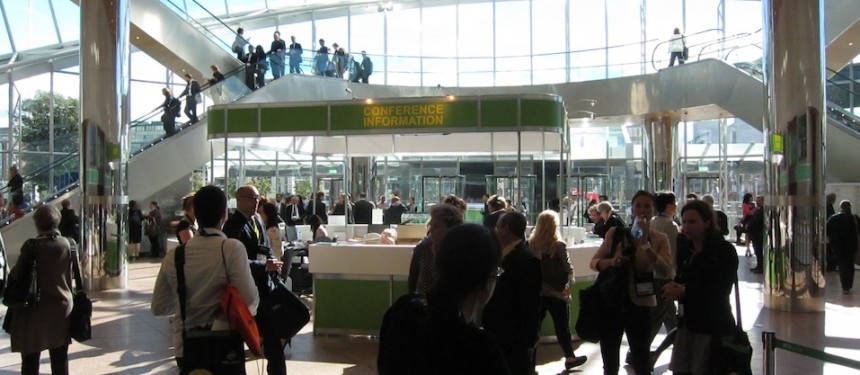From MOOCS to “higher education free zones”, the need for internationalisation to the damage it can cause, the European Association of International Education (EAIE) conference in Ireland last week drilled deep into the new trends reshaping international HE in Europe and beyond.
News and business analysis for Professionals in International Education
Have some pie!
EAIE conference ‘rethinks’ IE’s imperfect future

The conference took “change” as a starting point, as many European universities try to adjust to a new operating landscape in which funding is being pulled at home, yet demand for overseas has never been higher.
Presided over by the dynamic outgoing EAIE president, Gudrun Paulsdottir, the 4,300 delegates enjoyed four sunny days in Dublin combining concurrent sessions, exhibition halls, dialogues and networking events as well as outstanding plenary speakers.
Outlining just how tough the financial situation has become in European academia, Christophe Terrasse of EFMD, the Management Development Network, Brussels, explained how many low enrolment courses and departments had been closed on the continent, with fee rises unlikely to be more than a quick fix and increased privatisation likely.
Paulsdottir said that English medium education – a big theme – was on the rise in response, enabling universities to compete more effectively for overseas students. So too the number of countries going against prevailing European norms and introducing tuition fees for those from outside the EU.
“It is a fact that no country across Europe today, except perhaps Germany, can afford their higher education system”
“We will probably see this growing across Europe,” Paulsdottir told The PIE News. “It is a fact that no country across Europe today, except perhaps Germany, can afford their higher education system. It is quite a dramatic change and I think when you take that step you have to do so with thorough reflection and looking at the consequences.”
Sweden – which introduced fees in 2011 – was one of many countries with a large presence in the expo hall under the Study in Sweden banner. Members of the contingent explained that allowing better part-time work rights for international students, to enable them to offset the cost of fees, was one discussion point within the HE community.
The conference by no means limited its purview to Europe, with a wide range of sessions addressing trends in US higher education, the Middle East and East Asia among other topics.
During the session “The global financial crisis: implications for the future of international higher education” , James Jowi from the African Network for Internationalisation of Education (ANIE) said that while growing itself, Africa was struggling to access European scholarship funds – vital to its exchange initiatives – due to the euro crisis, although the inevitable slowing of brain drain could actually benefit African universities in the long term.
John Hudzik of Michigan State University said public spending cuts had not slowed internationalisation at US universities, but noted the difficulty of recruiting “in a market where the average fee discount is 43%” due to the diminished spending power of overseas students.
And the story in China was again different: Gordon Cheung of the Chinese University of Hong Kong said that while a bubble may lie ahead, China had actually benefited as a study destination since 2008. “Students are attracted to economic stability,” he said.
It was perhaps the backdrop of uncertainty that galvanised the event, with delegates showing clear appetite for increasing exchange and boosting bottom line earnings.
There was also a huge focus on innovation in the face of changing circumstances. Education researcher Prof Sugata Mitra’s opening plenary on Indian slum children educating themselves with a computer – but no guidance on how to use it – provided inspiration on perceptions of learning.
“They are somewhere between a tourist and immigrant status”
A large scale example of this, Massive Open Online Courses – free courses offered globally by top universities such as Stanford – were also discussed at length with Simon Marginson, a professor of higher education at the University of Melbourne, describing them as the “big game-changer”, although others remained unconvinced.
International student welfare was also on the agenda and a reminder to the sector that increasing overseas enrolments must be done sustainably. EAIE unveiled its new Student Mobility Charter, which promises to monitor the impacts of global mobility for good and bad; increase transferability of financial aid for study; and most importantly serve as a body to protect overseas student rights.
Said Paulsdottir: “Students that are mobile throughout the world are almost without any rights. They are somewhere between a tourist and immigrant status, meaning that whatever happens you have nothing that protects your right to actually stay and study.
“We’ve seen this in Libya, when Gaddafi disappeared and thousands of students were left without funding and had to go home… Students can also be subjected to very arbitrary decisions by universities or governments and have no right to object, as has been the case with London Metropolitan University.”
Still looking? Find by category:




2 Responses to EAIE conference ‘rethinks’ IE’s imperfect future